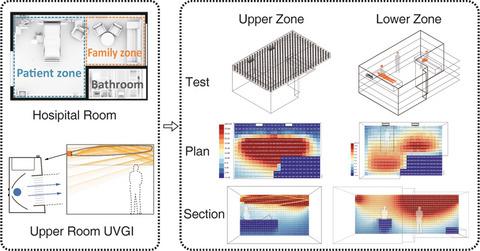当前位置:
X-MOL 学术
›
Indoor Air
›
论文详情
Our official English website, www.x-mol.net, welcomes your
feedback! (Note: you will need to create a separate account there.)
Spatial analysis of the impact of UVGI technology in occupied rooms using ray-tracing simulation
Indoor Air ( IF 4.3 ) Pub Date : 2021-03-26 , DOI: 10.1111/ina.12827 Miaomiao Hou 1, 2 , Jovan Pantelic 3, 4 , Dorit Aviv 1
Indoor Air ( IF 4.3 ) Pub Date : 2021-03-26 , DOI: 10.1111/ina.12827 Miaomiao Hou 1, 2 , Jovan Pantelic 3, 4 , Dorit Aviv 1
Affiliation

|
The use of Ultraviolet Germicidal Irradiation (UVGI) devices in the upper zones of occupied buildings has gained increased attention as one of the most effective mitigation technologies for the transmission of COVID-19. To ensure safe and effective use of upper-room UVGI, it is necessary to devise a simulation technique that enables engineers, designers, and users to explore the impact of different design and operational parameters. We have developed a simulation technique for calculating UV-C fluence rate within the volume of the upper zone and planar irradiance in the lower occupied zone. Our method is based on established ray-tracing light simulation methods adapted to the UV-C wavelength range. We have included a case study of a typical hospital patient room. In it, we explored the impact of several design parameters: ceiling height, device location, room configuration, proportions, and surface materials. We present a spatially mapped parametric study of the UV-C irradiance distribution in three dimensions. We found that the ceiling height and mounting height of the UVGI fixtures combined can cause the largest variation (up to 22%) in upper zone fluence rate. One of the most important findings of this study is that it is crucial to consider interreflections in the room. This is because surface reflectance is the design parameter with the largest impact on the occupant exposure in the lower zone: Applying materials with high reflectance ratio in the upper portion of the room has the highest negative impact (over 700% variation) on increasing hot spots that may receive over 6 mJ/cm2 UV dose in the lower occupied zone.
中文翻译:

使用光线追踪模拟对 UVGI 技术对有人房间的影响进行空间分析
在有人居住的建筑物的上部区域使用紫外线杀菌辐照 (UVGI) 设备已引起越来越多的关注,因为它是最有效的缓解 COVID-19 传播的技术之一。为确保安全有效地使用上层空间 UVGI,有必要设计一种仿真技术,使工程师、设计师和用户能够探索不同设计和操作参数的影响。我们开发了一种模拟技术,用于计算上部区域体积内的 UV-C 通量率和下部占据区域的平面辐照度。我们的方法基于适用于 UV-C 波长范围的已建立的光线追踪光模拟方法。我们包含了一个典型医院病房的案例研究。在其中,我们探讨了几个设计参数的影响:天花板高度、设备位置、房间配置、比例和表面材料。我们在三个维度上提出了 UV-C 辐照度分布的空间映射参数研究。我们发现 UVGI 灯具的天花板高度和安装高度相结合会导致上部区域注量率的最大变化(高达 22%)。这项研究最重要的发现之一是考虑房间内的相互反射至关重要。这是因为表面反射率是对下部区域居住者暴露影响最大的设计参数:在房间上部应用具有高反射率的材料对增加热点的负面影响最大(变化超过 700%)可能接收超过 6 mJ/cm 我们在三个维度上提出了 UV-C 辐照度分布的空间映射参数研究。我们发现 UVGI 灯具的天花板高度和安装高度相结合会导致上部区域注量率的最大变化(高达 22%)。这项研究最重要的发现之一是考虑房间内的相互反射至关重要。这是因为表面反射率是对下部区域居住者暴露影响最大的设计参数:在房间上部应用具有高反射率的材料对增加热点的负面影响最大(变化超过 700%)可能接收超过 6 mJ/cm 我们在三个维度上提出了 UV-C 辐照度分布的空间映射参数研究。我们发现 UVGI 灯具的天花板高度和安装高度相结合会导致上部区域注量率的最大变化(高达 22%)。这项研究最重要的发现之一是考虑房间内的相互反射至关重要。这是因为表面反射率是对下部区域居住者暴露影响最大的设计参数:在房间上部应用具有高反射率的材料对增加热点的负面影响最大(变化超过 700%)可能接收超过 6 mJ/cm 我们发现 UVGI 灯具的天花板高度和安装高度相结合会导致上部区域注量率的最大变化(高达 22%)。这项研究最重要的发现之一是考虑房间内的相互反射至关重要。这是因为表面反射率是对下部区域居住者暴露影响最大的设计参数:在房间上部应用具有高反射率的材料对增加热点的负面影响最大(变化超过 700%)可能接收超过 6 mJ/cm 我们发现 UVGI 灯具的天花板高度和安装高度相结合会导致上部区域注量率的最大变化(高达 22%)。这项研究最重要的发现之一是考虑房间内的相互反射至关重要。这是因为表面反射率是对下部区域居住者暴露影响最大的设计参数:在房间上部应用具有高反射率的材料对增加热点的负面影响最大(变化超过 700%)可能接收超过 6 mJ/cm2较低占用区的紫外线剂量。
更新日期:2021-03-26
中文翻译:

使用光线追踪模拟对 UVGI 技术对有人房间的影响进行空间分析
在有人居住的建筑物的上部区域使用紫外线杀菌辐照 (UVGI) 设备已引起越来越多的关注,因为它是最有效的缓解 COVID-19 传播的技术之一。为确保安全有效地使用上层空间 UVGI,有必要设计一种仿真技术,使工程师、设计师和用户能够探索不同设计和操作参数的影响。我们开发了一种模拟技术,用于计算上部区域体积内的 UV-C 通量率和下部占据区域的平面辐照度。我们的方法基于适用于 UV-C 波长范围的已建立的光线追踪光模拟方法。我们包含了一个典型医院病房的案例研究。在其中,我们探讨了几个设计参数的影响:天花板高度、设备位置、房间配置、比例和表面材料。我们在三个维度上提出了 UV-C 辐照度分布的空间映射参数研究。我们发现 UVGI 灯具的天花板高度和安装高度相结合会导致上部区域注量率的最大变化(高达 22%)。这项研究最重要的发现之一是考虑房间内的相互反射至关重要。这是因为表面反射率是对下部区域居住者暴露影响最大的设计参数:在房间上部应用具有高反射率的材料对增加热点的负面影响最大(变化超过 700%)可能接收超过 6 mJ/cm 我们在三个维度上提出了 UV-C 辐照度分布的空间映射参数研究。我们发现 UVGI 灯具的天花板高度和安装高度相结合会导致上部区域注量率的最大变化(高达 22%)。这项研究最重要的发现之一是考虑房间内的相互反射至关重要。这是因为表面反射率是对下部区域居住者暴露影响最大的设计参数:在房间上部应用具有高反射率的材料对增加热点的负面影响最大(变化超过 700%)可能接收超过 6 mJ/cm 我们在三个维度上提出了 UV-C 辐照度分布的空间映射参数研究。我们发现 UVGI 灯具的天花板高度和安装高度相结合会导致上部区域注量率的最大变化(高达 22%)。这项研究最重要的发现之一是考虑房间内的相互反射至关重要。这是因为表面反射率是对下部区域居住者暴露影响最大的设计参数:在房间上部应用具有高反射率的材料对增加热点的负面影响最大(变化超过 700%)可能接收超过 6 mJ/cm 我们发现 UVGI 灯具的天花板高度和安装高度相结合会导致上部区域注量率的最大变化(高达 22%)。这项研究最重要的发现之一是考虑房间内的相互反射至关重要。这是因为表面反射率是对下部区域居住者暴露影响最大的设计参数:在房间上部应用具有高反射率的材料对增加热点的负面影响最大(变化超过 700%)可能接收超过 6 mJ/cm 我们发现 UVGI 灯具的天花板高度和安装高度相结合会导致上部区域注量率的最大变化(高达 22%)。这项研究最重要的发现之一是考虑房间内的相互反射至关重要。这是因为表面反射率是对下部区域居住者暴露影响最大的设计参数:在房间上部应用具有高反射率的材料对增加热点的负面影响最大(变化超过 700%)可能接收超过 6 mJ/cm2较低占用区的紫外线剂量。











































 京公网安备 11010802027423号
京公网安备 11010802027423号